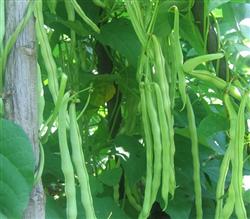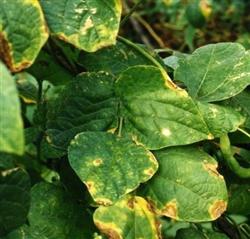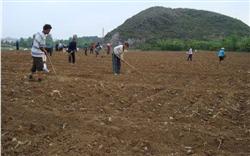Picture video of cowpea planting technology

Cowpea is rich in nutrition, delicious, citizens love to eat, vegetable farmers love to plant in the north and south of our country, especially in the south, cowpea is divided into long cowpea and short cowpea. At present, we mainly cultivate cowpea. The planting network has sorted out the cowpea planting technology, which is listed below for netizens' reference. First, the selection of cowpea varieties: 1. Xiang cowpea No. 1: it is precocious and high yield. it is cultivated in spring, summer and autumn, which is 2-4 days earlier than cowpea 28, which increases the yield by about 20% and the total yield by 10-20%. The general yield per mu is 3000 kg, with few branches, strong growth potential, fertilizer resistance, light green pods, sturdy, neat and uniform, and excellent commercial quality. 2. Xiang cowpea No. 2: precocious and high-yielding, cultivated in spring, summer and autumn, listed 2 days earlier than cowpea 28 Mel 2, the yield increased by 20% in the early stage, and the total yield increased by 10%. Generally, the yield per mu is 3000 kg, with few branches, strong growth potential, fertilizer resistance, green pods, sturdy, neat and uniform, thick and tender meat and excellent commercial quality. 3. Cowpea No. 3: it is a newly bred variety with late maturity and high yield. it can be sown and cultivated from Qingming Festival (early April) to late July in the Yangtze River Basin, which is heat-resistant and ridge-tolerant, and it is cultivated late in high temperature season. Its yield and quality are obviously better than other varieties. The pod is green and white, neat and uniform, the pod is tender and delicate, and the commodity is excellent. If the condition of fertilizer and water can keep up, the phenomenon of "rat tail" seldom appears in the later stage of harvest. 2. Seedling methods and planting methods of cowpea: 1. Reasons for cowpea breeding: cowpeas of early-maturing varieties in spring are generally sown around Qingming, and varieties cultivated in different seasons should be selected according to variety characteristics, generally early-maturing, heat-resistant varieties should be cultivated in spring, late-maturing and heat-resistant varieties should be cultivated in summer, cowpea can be nurtured and transplanted, or direct seeding, and the direct seeding temperature of cowpea in spring is low. Slow germination, low temperature, overcast and rain, seeds easy to mildew rotten seeds, poor seedling emergence, and direct seeding stems and leaves exuberant pods less. Seedling transplantation can inhibit vegetative growth, promote flowering and pod, and is beneficial to the whole seedling, but also can advance and prolong the harvest period, cowpea cultivation in autumn, generally high temperature, feasible direct seeding. 2. The method of raising cowpea seedlings: the soil of the seedling bed should be loose and tight, prevent the main root from going deep into the soil, and promote multiple lateral roots. The drainage condition of seedbed soil is better. The soil should not be too wet, so as to prevent rotten seeds from sprouting, or the occurrence of quenching disease and rotting roots and dead seedlings, raising seedlings in early spring, during the period from sowing to the emergence of seedlings, the seedling bed must be covered with a film, one is to increase soil temperature and promote seed germination; the second is to avoid direct scouring by Rain Water, increase seedbed temperature, reduce soil moisture, and increase germination rate. 3. Cowpea transplanting and planting method: cowpea is cultivated in spring, the general soil width (Bao Amoy) is 1.5 m-1.8 m, the row spacing is 60-80 cm, the plant spacing is 26 cm and 40 cm, and there are 4 plants per hole. Too dense will cause early yellowing and shedding of the middle and lower leaves of the plant, which is not fruiting in the early stage, and can be planted densely in summer and autumn. The reasonable close planting of cowpea should be determined according to the characteristics of the variety, the varieties with too many leaves, many branches and high branches should be sparsely planted, otherwise they should be close planted properly. At the same time, the planting density should also take into account the level of fertility, high fertility level should be properly sparse planting, on the contrary, it can be properly close planting. Note: in summer and autumn cultivation, if seedling transplanting is adopted, plastic film must not be covered on the seedling bed due to high temperature, so as to avoid "boiling seed" and reduce the germination rate. it is best to cover the seedling bed with a layer of straw after sowing to avoid Rain Water scouring, resulting in the hardening of the seedling bed and affecting the seed emergence. Cowpea transplanting, it is appropriate to plant seedlings, generally after the cotyledons unfold, the first pair of true leaves before planting, in the process of fixing sandalwood, try to avoid damage to cotyledons and affect the growth of seedlings. 3. Management methods of cowpea growing period: 1. Water management of cowpea: cowpea is in the trailing period, which is also the period when root nodules begin to form and increase rapidly. In this period, the soil moisture is too high, which is not conducive to root development and nodule activity. In the flowering and podding stage, it is necessary to supply sufficient water to keep the soil moist, otherwise it will result in fewer flowers and pods, short pods and thin pods, lower quality and lower yield, but too much water will easily lead to overgrowth of plants. drop flowers and pods, and easily lead to root rot, rotting roots and dead seedlings. Therefore, in cowpea cultivation, attention should be paid to the control of moisture, and the effective measures are to select fields with convenient drainage and irrigation to carry out deep furrow and high border cultivation, cowpea should pay attention to clear ditch and drainage, summer and autumn cowpea should pay attention to timely watering. 2. The fertilization method of cowpea: the rhizobium of cowpea is underdeveloped, and in the early stage of plant growth, the nodule is in the stage of formation. Supplying a certain amount of nitrogen fertilizer can promote the growth of seedlings and accelerate the formation of nodules, but nitrogen fertilizer should not be applied in combination with phosphorus and potash fertilizer. Cowpea cultivation with sufficient organic fertilizer as base fertilizer can increase soil temperature and promote nodule activity, form root nodules early, accelerate plant growth, and early daily harvest. Generally, the amount of base fertilizer per mu is more than 50 ∞ kg of organic fertilizer, 30 kg of calcium superphosphate, 15-20 kg of potash, or 75 kg of plant ash. In addition, 50-75 kg of lime is added to acid red soil. The application of basic fertilizer should be combined with deep ploughing and soil preparation, slow-acting fertilizer should be applied before deep ploughing, turned in the lower layer of the soil, and then fully mature human and animal fertilizer and quick-acting fertilizer should be applied to the topsoil during soil preparation. Before cowpea blossoms and bears pods, there is little demand for fertilizer and water. If there is too much fertilizer and water, the plant stems and leaves grow too vigorously, only long vine leaves will be formed, inflorescences are few, pyrene pod nodes will rise, lateral buds sprout, and the middle and lower parts will not bear English. Therefore, fertilizer and water should be properly controlled in the early stage to inhibit excessive vegetative growth, and 15% concentration of human and animal manure should be used after the transplant survived. Add a small amount of nitrogen fertilizer for the first time to promote the growth of seedlings. After the vine is drawn, it is topdressing with 20% human and animal manure at the concentration of 20%. After flowering and podding, the demand increases gradually, and 30% human and animal manure is applied every 6 days to promote growth, multi-flowering, multi-podding, and podding. The need for more fertilizer and water, such as lack of fertilizer and water, will lead to decline, falling flowers and pods, then re-applying topdressing in time can prevent premature senescence, promote flower turning and prolong harvest and increase yield. 3. The construction method of cowpea: after the planting survived, during the period before setting up the frame, after the heavy rain and topdressing, the middle tillage should be carried out in order to have good air permeability and be beneficial to the growth of root system and the activity of rhizobium. In the first intertillage, it should be a little deeper, with the root system growing and the distribution growing, the depth of intertillage should be gradually from deep to shallow, and the last one should be the shallowest. Generally, intertillage should be stopped and weeds should be pulled out in time after setting up the frame. When the vine is about 34 cm long, it should be set up in time to draw the vine, the direction of which revolves around the bean pole from left to right, in the form of bird's nest frame, herringbone frame, hedgerow frame (one-stop dragon), in which the hedge frame has good ventilation and light transmission conditions and high yield. 4. Prevention and control of diseases and insect pests of cowpea: 1. The harm and control methods of cowpea rust: the rust is mainly harmful leaves, which occurs on the back of leaves, and is susceptible to disease under the condition of high temperature and humidity. After the damage of leaves, small yellow-white spots are born, and then gradually expand into a pile of yellow-brown spores, and there is often a yellow halo around the pile of summer spores. Control methods: mainly after harvest, remove the disease and residue in the field and burn it centrally. 65% Dysen zinc powder 500 times, 70% methyl topiramate, or 50% carbendazim 100 times solution all have control effect. 2. The harm and control methods of cowpea coal mildew: coal mildew is mainly harmful to leaves, and high temperature and humidity are beneficial to the disease. at the beginning, the leaves have purple-brown spots on both sides, and then expand to a round spot of 1-2 cm, and the edge is not obvious. the surface of the disease spot is dense with smoky mold. Prevention and control methods: after harvest, burn the remains centrally, 50% topiramine or 50% carbendazim 1000 times solution, 65% Lin zinc, 500 times solution sprayed every 7 days. 3. The harm of cowpea pod borer and its control methods: the adults lay eggs in flower buds and tender parts, mainly damaging flower buds and young seeds in pods, which often occur in large numbers under the condition of high temperature and humidity from June to August, and chemical control should be carried out before the third instar stage of larvae. Control method: use 80% dichlorvos 800x or 90% trichlorfon 100x liquid, you can also use enemy kill 3000 times liquid-5000 times liquid to spray. 4. The harm of cowpea aphid and its control methods: the air humidity of cowpea aphid is small in Jiuqing, and the occurrence of temperature is more serious at 20 min / 30 ℃. Prevention and control method: spray control with 50% dichlorvos EC 1500 murine 2000 times or 40% dimethoate EC 1000 2000 times. Click to get more bean planting techniques click to get more vegetable planting techniques
- Prev

How to control bean anthracnose?
What are the dangers of bean anthrax? How to control bean anthracnose? Please also understand the net friend to help introduce the cultivation network collated bean anthracnose harm and prevention methods, the following detailed list for the reference of netizens. The harm of bean anthracnose: bean anthracnose belongs to fungal disease, in more dew,...
- Next

Ginger planting techniques: how to increase ginger production?
Is there any way to increase the output of ginger? Also ask experienced netizens to help introduce the method of growing ginger in order to get a good yield. The following farming network lists several key points of high ginger yield for netizens' reference. Point one, the choice of ginger cultivation land: ginger likes warm and moist climate, it is appropriate to choose soil.
Related
- Where is it suitable to grow horseradish in China? it is expected to see the middle altitude horseradish in Alishan.
- How to prevent tomato virus disease reasonably? (Control methods included)
- Many people like to plant towel gourd on the balcony. What are the main points of this method and management?
- What crops can chili peppers be mixed with?
- Fertilization techniques and matters needing attention in Tomato
- What are the grafting techniques for peach seedlings in spring?
- Harm and control methods of root swelling disease of Chinese cabbage
- What are the pests of sweet potatoes? How to prevent and cure it?
- Symptoms, causes and Control methods of navel Rot in Tomato
- The cause of "Cucumber rotten bibcock" in Farmers' planting Cucumber and its Control Plan

